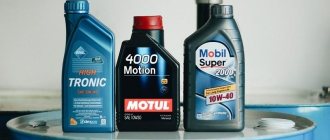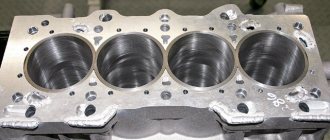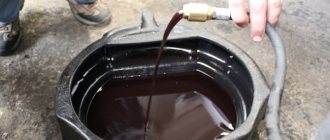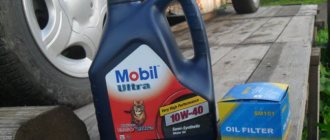13.04.2018
“Which oil is best to put into the engine?” - Every motorist probably asks this question. The engine oil market offers a huge range of different liquids, from which it is really quite difficult to choose.
There cannot be a definite answer to the question of what kind of oil to pour into the engine, since everyone’s cars are different, their engines are different and the operating conditions of many cars are different. After reading this article, you will learn how to choose the best motor oil and what you should base your choice on.
Advice from auto manufacturers
When choosing engine oil for the winter, the best advice is to refer to the vehicle manufacturer’s recommendations. When designing a power plant, engineers carry out a large number of tests on the motor, including to select the optimal lubricant for various operating conditions. All you need from the user is to look at the instructions.
Those motorists who, for a number of reasons, do not have the opportunity to obtain such information find themselves in the worst conditions. For example, a given car brand is no longer produced, or information on it is outdated or missing. In this case, responsibility falls on the shoulders of the owner, and here knowledge and experience in the field of classification and characteristics of motor oil will come in handy.
Chemical composition of motor oils, types
When internal combustion engines appeared, only mineral oils made from natural petroleum components were used as lubricants. With the onset of winter, the use of such oils was difficult. At temperatures below −10°C, the lubricant in the engine froze.
With the advent of oil based on synthetics, the situation changed. This type of oil had relatively stable characteristics when changing ambient temperatures.
Working to reduce the cost of synthetic oils, the developers created a semi-synthetic motor oil based on mineral oil with the addition of artificial additives.
Each type of oil has its own advantages and disadvantages:
- Mineral lubricant does not tolerate low temperatures well, but it slowly and gradually cleanses the power plant of soot and slag. Thanks to the small size of debris particles, this minimizes the risks associated with their presence in the lubrication system. When changing the oil, debris is removed from the engine along with waste.
- Semi-synthetics have greater stability in the temperature range. However, it is also not suitable for winter, since its minimum temperature threshold does not correspond to the frosts of our region.
- Synthetics, like winter motor oil, are the best and only option today. It is most popular, it is designed for a wide temperature range, does not lose its characteristics and properties even with strong differences. However, when using it you need a competent approach. So, if you pour synthetic oil into an engine that has a lot of internal contamination, it will have a strong effect on deposits. Having peeled off, pieces of debris will clog the channels and filters of the motor, which will lead to a complete repair of the unit.
Thus, when purchasing used equipment and there is no information about what kind of engine oil was poured into the unit earlier, it is advisable to first rinse it with a special cleaning fluid, and only then pour the oil into the engine.
Viscosity and car manufacturer requirements
Viscosity is the main criterion by which motor oil for winter should be selected. The fact is that during engine operation, all involved parts rub against each other at high speed. This inevitably leads to rapid deformation and wear. Car oils poured under the hood at any time of the year prevent negative aspects by forming a protective film on all mechanisms. The thickness of the protective film should fill the gaps between the elements provided by the design, without creating interference in their movements. The thickness of the oil layer is affected by the viscosity of the engine oil. But how do you know what kind of liquid should be poured into the engine in winter?
Viscosity of motor oils at a temperature of - 20 degrees
The degree of viscosity of fuel and lubricants required for correct engine operation is indicated by the manufacturer in the vehicle’s operating manual. And you can’t ignore the recommendations. If the oil is too viscous, cranking the crankshaft in low-temperature conditions will be difficult: the car will have to make considerable efforts to start the engine. Excessive thickness will also not allow the oil to spread over the working surface of the components in a matter of seconds, which means that part of the structure will be subject to the greatest friction force.
Winter motor oils for passenger cars should also not have too much fluidity. If the thick lubricant can still “linger” on the surface of the mechanisms, then the liquid one will simply flow over them like water. A viscosity that is too low cannot protect the structure in harsh low temperature environments.
Lubricant viscosity
When choosing which oil to pour into your power plant, you need to pay special attention to such an indicator as oil viscosity. This is the main characteristic that has a major impact on the quality and durability of the engine.
When the power plant operates, friction forces act on the parts. Thanks to the oil, an oil film is formed between the rubbing parts and elements. The purpose of the film is to reduce the friction force, remove heat from the friction point, ensure tightness, and reduce wear.
With increased viscosity, which occurs due to low temperatures, the engine experiences increased load. To move parts, it is necessary to apply more effort and it is difficult to achieve normal operating temperature conditions. If you use too thin an oil, it will not stick to the parts and will cause increased wear on the installation due to strong metal-on-metal friction.
The difficulty in selecting a lubricant for a power plant during cold periods lies in the wide temperature range of engine operation. In severe frost, this range varies from −30°C to +90°C. Motor oil, being at the lowest point of this range, becomes very thick, and at the upper point it becomes very thin. To solve this issue, you need to find a lubricant such that its properties remain stable no matter what temperature it is at the moment.
Types of motor oil
Motor oils for automobile engines are usually divided into categories on a basic basis. Mineral lubricants are obtained by direct distillation of petroleum.
To improve performance characteristics, additives are added to the liquid.
Synthetic oils are obtained using hydrocracking technology or natural gas processing (depending on the manufacturer), semi-synthetic materials are a mixture of mineral lubricants with synthetic additives.
Mineral
Mineral liquids have a reduced cost since production does not require the use of special installations. The liquid loses fluidity when the temperature drops to -20°C and below, and at increased loads it burns out. The additives introduced into the composition protect engine parts from wear, but degrade after 5-6 thousand kilometers. The materials are used for power plants without hydraulic compensators and for engines with long mileage. The oil film partially compensates for wear of parts.
Synthetic
The synthetic base has increased resistance to external influences. Oil loses fluidity when cooled to -40°C and below. Additional additives reduce friction and remove foreign deposits from the walls of the engine crankcase. When pouring oil into an old power unit, the channels may become clogged with washed-out dirt. Due to increased penetrating power, lubricant flows through hardened oil seals and deformed gaskets between engine parts.
Semi-synthetic
Semi-synthetics have increased performance characteristics at a reduced price. Antifriction and detergent additives are introduced into the material; the quantity and list of additional elements depend on the brand and manufacturer.
Winter lubricant
According to the SAE classification, oils are divided by type of use depending on the season. So, in winter, when choosing oil for a car, it is correct to give preference to winter oil. According to the classification, its correct designation is the letter W (winter). The label must indicate the SAE classifier, a number corresponding to the minimum temperature at which the oil does not lose its properties and the seasonality indicator W. For example: SAE 10W.
The disadvantage of winter oils is that they must be filled before the onset of cold weather, regardless of how much mileage was achieved with the previous oil. In addition, if in winter the ambient temperature rose to above zero, the oil became very liquid and increased wear on the power plant.
Which oil is best for winter and does it need to be changed?
The question is closely related to the previous section. Let's find out if the notorious “winter oil” exists? As we know, the first digit in the SAE viscosity designation characterizes the cold start temperature. That is, with given high-temperature viscosity characteristics (for example, 30), winter engine oil will be designated 0W30, and summer oil will be designated 10W30.
The difference is visible in the illustration:
In some regions where seasonal temperatures differ by 60°C, the appropriate viscosity type is poured each season. If the change in winter and summer coincides in mileage with the timing of maintenance, you will not have to worry about the question: “Which oil is better to fill in?” In summer, the value of high-temperature viscosity is higher, in winter it is lower.
And if, according to mileage, the oil needs to be changed once a year?
In this case, it is better to pay attention to the base of the lubricant. Synthetic and semi-synthetic oils react differently to temperature changes. And mineral water depends so much on the temperature outside that adding lubricant out of season is detrimental to the engine.
What kind of oil should I fill in, synthetic semi-synthetic or mineral?
To understand which motor oil is best to pour into the engine, consider the difference between the types of base:
- Synthetics are made from chemical compounds of hydrocarbons. Without going into details, it is produced from natural gas. The viscosity of such a base is practically independent of the ambient temperature, so the general characteristics of the lubricant do not change, from a cold start to warming up to operating temperature. True, production is quite expensive, so pure synthetics cost a pretty penny
- a mineral analogue of any oil (although it would be more correct to say that mineral water has synthetic analogues) is created on the basis of natural raw materials, that is, oil. The cost is low, the price of the lubricant is attractive. What about the parameters? While the oil is “fresh”, the performance is no worse than that of expensive synthetics. However, the mineral base “wears out” quite quickly, if such a term can be applied to a liquid. In addition, mineral water greatly changes its viscosity depending on temperature. Until the engine warms up, in frosty weather it is better not to move. If you manage to turn the crankshaft at all;
- as usual, there is always a middle ground. Semi-synthetics have a low cost. And the characteristics, in some cases, are no worse than pure synthetics. In terms of service life, the indicators are unimportant. Therefore, such oil must be changed strictly according to the maintenance schedule. But the dependence on temperature is an order of magnitude better than that of mineral water.
All-season lubrication
Currently, the most popular are all-season lubricants. Their widespread use is associated with convenience. There is no longer a need to change the oil depending on the season; accordingly, the frequency of replacement has increased; now it is tied only to mileage.
According to the classification, all-season oils are designated by two numbers separated by the letter “W”. Example: 10W 40. The first number refers to the winter characteristics of the oil and tells what minimum temperature the lubricant can withstand while maintaining its parameters. The second number refers to summer characteristics and indicates the maximum positive temperature that the oil can withstand.
Each oil has a minimum and maximum operating limit, but the advantage is a wide temperature range and a large selection. Thus, based on the characteristics of the region, everyone can easily choose the product they need.
Oil, API classification
An indicator characterizing the quality of a lubricant was developed by the American Fuels Institute, thus a new classification appeared - API. It is not mandatory for all fuel manufacturers, but every self-respecting brand tries to emphasize its status by placing product information on the label in accordance with API. Thus, the absence of data is more likely to indicate a low-quality product than its presence.
There are two important designations in the classification: “S” informs the user that the product is intended for use only in gasoline power plants and “C” is the same, but for diesel units. In addition, it is allowed to use a double designation: S.../C..., or C.../S... Where the letter before the line indicates the preferred use of oil, after the line, the possible use.
| Class by API | Class value |
| Gasoline power plants | |
| SA, SB, SC, SD, SE, SF | Not used for engines manufactured in 1930-1989. |
| S.G. | For engines manufactured since 1989, protection against soot, corrosion, and oxidation. |
| SH | For installations since 1994, protection against soot, corrosion, oxidation, and wear of parts. Suitable if class SG or lower is recommended. |
| S.J. | For units younger than 1996. All previous qualities + improved anti-carbon protection, better performance in cold weather. Suitable for class SH and below. |
| SL | For multi-valve turbocharged engines manufactured since 2000. Increased quality control. Suitable for class SJ and below. |
| S.M. | Modern engines since 2004. Improved protection against premature wear and soot. Recommended for all lower grades. By far the best winter oil. |
| Diesel power plants | |
| CA, CB, CC, CD, CE | The classes are obsolete and not used. |
| CF | Engines since 1990 with indirect injection. Contains additives to reduce: corrosion, soot, wear, oxidation. Acceptable for use in CD class. |
| C.G. | Motors after 1995 Subject to increased loads. Prevents the formation of: soot, foam, soot, oxidation. |
| CH | Installations after 1998. All of the above qualities, in addition - an exhaust gas toxicity standard. |
| C.I. | The class was admitted in 2002. Complies with all environmental standards and has a cleansing effect. Reduces: soot, carbon deposits, increased fluidity. Today it is the best winter oil for diesel engines. |
Numbers 2 and 4: the oil is designed for a two-stroke or four-stroke engine.
Oil, ACEA classification
The ACEA standard (Association des Constracteurs Europeens des Automobiles) - Association of European Automobile Manufacturers is an analogue of API, only developed by European scientists. In 1996, the organization introduced a classification for engines, which is supported by such automobile manufacturers as: BMW, Ford, GM, Mercedes, Volkswagen, Volvo, etc.
According to the classification, it is necessary to take into account the wear resistance of the lubricant. The operating temperature range of the power plant varies from 80°C to 150°C. At any point in the temperature cut, the wear resistance characteristics of the oil must remain within acceptable limits.
The classification provides for the use of three classes - A, B, E. The classes have subcategories, are designated by numbers, followed by information about the year the class was introduced into work, or a later edition of the norm.
- A1, A2, A3, A4, A5 - gasoline internal combustion engines;
- B1, B2, B3, B4, B5 - light diesel power plants for low-power cars and trucks;
- E1, E2, E3, E4, E5, E7 - heavy diesel engines.
The numbers (subcategories) correspond to the levels of requirements; the higher the number, the higher the requirement. The exception to this rule are the “A1” and “B1” levels, since they refer to low-viscosity, “energy-saving” oils.
Classes B4 and B2 are the same, the only thing is that the first was tested on power plants with direct fuel injection.
Preparing for winter
Winter, with its sub-zero temperatures, brings a lot of trouble to every motorist. Snow and ice are only a small part; starting the engine in winter is a real problem, especially for untrained drivers, especially owners of diesel units.
Negative temperatures negatively affect the startup of the power plant; the car engine experiences enormous loads. Getting through the season painlessly requires preparation. The key to success is not only high-quality and correctly selected oil, but a whole range of measures to prepare for winter:
- Checking the condition of the battery and starter.
- Select the correct engine oil for the operating conditions.
- Check and replace power plant spark plugs and other electrical components.
- Replace oil, fuel, air filters.
- Check the level and condition of antifreeze.
- Use only high-quality fuel corresponding to the season of operation of the vehicle.
- Insulate the space under the hood to quickly warm up the unit and slow cooling.
Carrying out the entire range of work will allow us to approach the season of negative temperatures as efficiently as possible and get through it with minimal damage. It should be remembered that by choosing the right oil, but without undergoing preparation (and vice versa), you can easily damage the most modern unit. Enter the season wisely: with good oil and a prepared car.
Castrol Magnatec 5W-40
Owners of both trucks and passenger cars have left many positive reviews about this composition. It will help you keep your engine in good working order in cold weather, even when the car is used harshly.
Castrol Magnatec 5W-40 is suitable for harsh winters
We have introduced you to the most popular brands of oils for use in winter. Which one to choose is up to you, but we only hope that this article was useful to you.
- Author: d-gan
Rate this article:
- 5
- 4
- 3
- 2
- 1
(308 votes, average: 1.5 out of 5)
Share with your friends!








